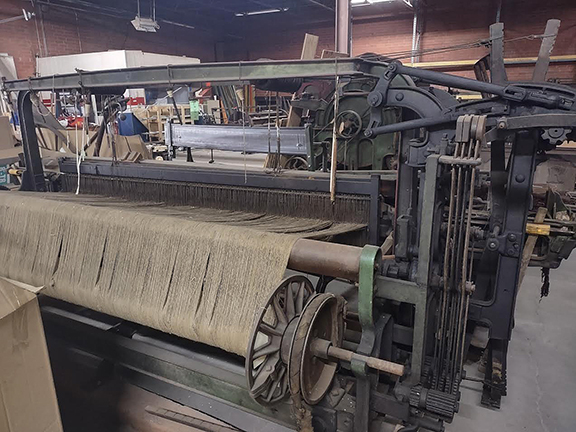Welcome!

This knitting machine at Cedar Falls dates back to 1840. Photo by Larry Penkava / Randolph Hub
Franklinville NC Textile Museum is coming to Randolph County
FRANKLINVILLE — It’s taken 40 years — filled with advocating, fund-raising, frustration, fires and vandalism, and enduring criticism — but Mac Whatley is finally seeing his dream coming true:
The North Carolina Textile Museum will be housed in not one but two old mills now owned by the Randolph Heritage Conservancy.
Whatley founded the conservancy in 1994 to find help to keep alive the Southern heritage of textile mill villages.
The museum’s location was announced by the NC Department of Natural and Cultural Resources, and it was a win for Franklinville and Cedar Falls.
With funds now available from the state and other sources, Whatley and his team are in the process of restoring the Cedar Falls Manufacturing Company buildings and creating a visitor center and exhibits at what’s left of Randolph Mills in Franklinville.
“We’re in the process of getting organized and cleaned up so people can visit,” Whatley said on Aug. 10.
That was just two weeks after the Randolph County Historic Landmark Preservation Commission recommended designation of the Cedar Falls mill as a historic landmark. The Franklinville Town Council has to approve the action. Franklinville’s mill site was designated several years ago and much of the Town of Franklinville is a National Historic District.
“I’ve been advocating for this about 40 years,” Whatley said.
An Asheboro native, he moved to Franklinville in 1978, about the time Randolph Mills shut its doors.
“I was impressed with the machines,” he said, and the process of making cloth “fascinated me, and the process of water power. That’s why I’ve been advocating” its preservation.
But it took the closure of so many textile mills in the South to get people engaged.
“Nobody was interested while it was a viable industry,” Whatley said. But with textile manufacturing going overseas, he said, “people were remembering, ‘When I was growing up … .’ ”
There are museums dedicated to textiles but most are in the Northeast, where the industry first sprang up in America. But they’re mostly displays in a room, Whatley said.
There were some early wins for the conservancy, particularly in 1995 when the NC Museum of History took some looms from Franklinville for display. “But they gave them back to us because they don’t have enough storage space,” Whatley said.
Whatley served on the board of the American Textile History Museum in Lowell, Mass., which was competing with other comparable museums in the Northeast. But when financial trouble came along, administrators considered taking machines to a scrap yard.
“The board didn’t like the idea,” instead hoping to send the collection to other organizations in the Northeast. “But nobody wanted 20,000 square feet of machines.”
Then Whatley talked to Kevin Cherry, assistant secretary of the Department of Natural and Cultural Resources. “They agreed to look at (the possibility of) a textile museum and did a feasibility study, the need for a museum.”
Whatley said the state looked at the former mills at Franklinville, Cedar Falls and Erwin in Harnett County. They found Erwin not appropriate.
Meanwhile, the museum in Massachusetts shipped its collection to Randolph County. The conservancy was able to buy the Cedar Falls buildings and that helped turn the tide for the NC Textile Museum being in Randolph County.
In fact, the state budget for 2022-23 includes $1 million for the museum.
Unfortunately, much of that will be spent on repairing the roof of a portion of the Cedar Falls facility. But Whatley expects more state money in the spring.
The conservancy has hired Joe Lyons as site manager, overseeing cleanup and renovations at the two sites. “There’s a lot more work to do with the buildings,” Whatley said.
It’s a work in progress, but Whatley now has a gleam in his eyes when he looks at the textile equipment inside the Cedar Falls mill waiting for expert hands to put them back into operation.
“We want to create a place where people can come and hang out,” he said, “places in Cedar Falls and Franklinville to bring people to. Parts of the museum will be doing stuff,” maybe even making cloth.
Machines at Cedar Falls are dated from the 1780s to the 1970s. Among them are looms, spinning machines and knitting machines.
Both the Cedar Falls and Franklinville mills date back to the 1840s, with business charters in the 1830s.
Whatley foresees the twin museums as part of more activity by visitors. They’re not only connected by Deep River but also by the Deep River Rail Trail.
While the Cedar Falls mill is pretty much intact, Franklinville’s attraction is its mill village. Whatley said there were 41 tenements built for mill workers and that 26 are still standing. He indicated that the conservancy hopes to include the village aspect into the overall museum experience.
Franklinville will also have a working steam engine, a hydroelectric generator and exhibits of mill village life.
Said Whatley: “This is a critical part of Randolph County heritage, the cotton industry and the cultural and social impact.”
